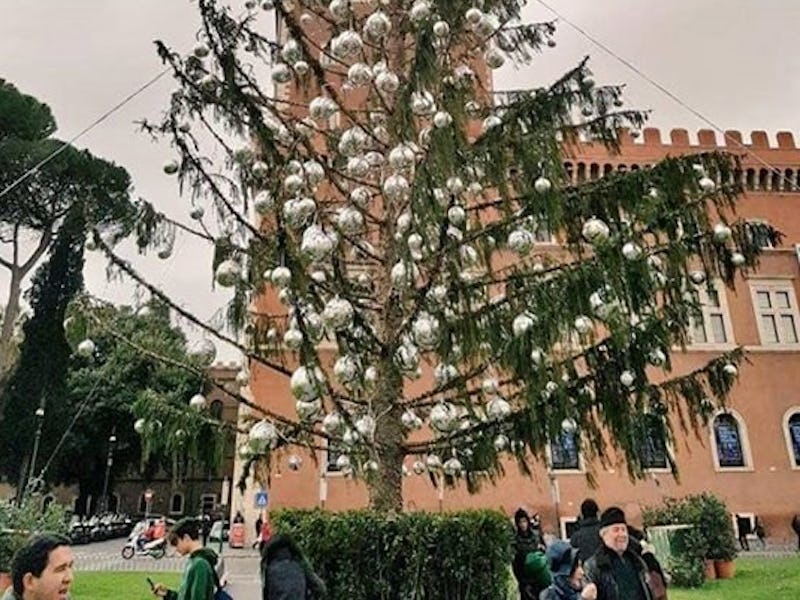Science Explains Why Rome's Sad, Balding Christmas Tree Is Beyond Saving
R.I.P. Spelacchio.

In 1965, the animated classic A Charlie Brown Christmas honored a sad, skinny, balding Christmas tree, transforming it into a rich symbol of holiday spirit and a totem for underdogs everywhere. The citizens of Rome, however, do not appear to have taken the message of this beloved film to heart. Romans are irate about the threadbare Christmas tree that’s been put up in the Piazza Venezia, one of the city’s busiest squares, nicknaming the sad spruce Spelacchio — Italian for “balding.”
It is a sorry sight indeed, and city officials announced Tuesday they were investigating the reason for its untimely demise.
The 65-foot-tall tree has been losing its needles since it was set up on December 8, at a cost of a $55,000. Some are blaming the carelessness of its transporters, who, according to the Italian paper Il Messaggero, didn’t properly cover the tree when it was brought over from the Dolomites in northern Italy. Some say it’s because of the indelicate way the tree was unloaded once it got to Rome.
Others blame the suppliers for sending a sick tree, though a spokesperson for the company told Corriere Della Sera that it was “in excellent health” when it was shipped. Still others pointed at the tree’s lack of roots for its untimely death, but, barring those on the farm, what Christmas tree has roots?
Aren’t all Christmas trees, in a way, already dead?
That said, some trees die a slower, more graceful death than others. Spelacchio seems to be dying in a hurry, and that might be the result of a number of factors.
If the tree is indeed a spruce from Tyrol, an alpine region in Northern Italy, then it’s very likely a Picea alpestris, also known as a Norway spruce of Alpine spruce, which are the dominant spruce species in the region. A report from the United States Department of Agriculture Forest Service called the Pocket Guide to Christmas Tree Diseases notes that these trees are usually “devoid of diseases” but points out that “Norway spruce, being an exotic, is subject to winter injury.” However, Norway spruce is only an exotic in the U.S., so its susceptibility to injury in (or at least near) its native habitat isn’t clear.
In the U.S. at least, Norway spruces growing on Christmas tree plantations can get infected with a fungus called Rhizosphaera needlecast, which turns needles purplish-brown and cause them to fall prematurely. This fungus, which mostly affects the Colorado Blue Spruce (a U.S native), also causes “fuzzy, black, fruiting bodies” to stick out of pores on infected needles. This might be the cause of the tree’s sickliness, but you’d think that, with all the close-up shots being taken of Spelacchio, that someone would have noticed those by now.
It may be that Spelacchio succumbed to weird, warmer weather, like many spruce and fir trees did in 2015, when the British Christmas Tree Growers Association fielded harsh criticism from customers angry about their dying trees.
At the time, the BCTGA’s secretary, Harry Brightwell, told the Mirror that trees “like to have a bit of cold and frost. It’s more important this year to look after the tree due to the weather.” In recent years, scientists have voiced concerns about the South Tyrol region succumbing to the warming effects of climate change.
Then again, the blame may be solely on the humans who dealt with the poor tree. According to Raj Lada, Ph.D., of Nova Scotia’s Christmas Tree Research Center (a real thing), a very important step in setting up a Christmas tree is giving its trunk a fresh cut, and even scoring the wood a few times, in order to maximize the amount of water it absorbs from its (hopefully) water-filled base.
“[Don’t] forget to refill the reservoir. I think that’s one of the most important things,” he said in an interview with NPR in 2010. This is Christmas tree care 101, but if Spelacchio’s dismal looks are any indication, someone definitely skipped class that day.
Rome should probably have checked in with Lada once they knew something was wrong with the tree. In 2010, Lada published a paper in the journal Trees in which he reported discovering a chemical that made Christmas trees keep their needles twice as as long as they usually do.
Snarkier citizens had tried planning a Christmas day funeral for Spelacchio on Facebook, though that appears to have been canceled. There might still be a chance that Romans might learn to look past the sad tree’s impoverished looks and learn to embrace it, the way Charlie Brown’s pals did on Christmas Eve in 1965 — that is, if they ever manage to get over the Vatican’s show-stopping tree across the Tiber River.
Check out this video of a working windmill made out of trash.